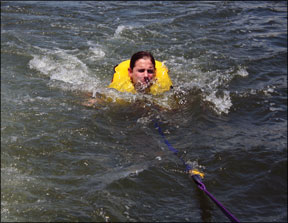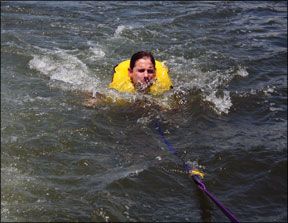As a follow-up to last weeks blog post on safety tethers, it is important to note that these devices are just one component in a system that includes the jackline and a safety harness (typically combined with a personal floatation device, or PFD) and that these components should be evaluated together as a whole. We looked at jacklines in April 2007, and we tested inflatable life jacket-safety harness combos in two different issues,December 2006 and August 2008. The type of harness you have is particularly important when considering tethers.

One of the chief questions about an inflatable PFD-harness is whether you want an auto-inflating PFD or a manually inflating model. (Some sailors prefer just a harness without any integral flotation, also an option.) The auto-inflating devices are activated by water or pressure change; manual-inflating devices require the wearer to pull a lanyard. Commonsense would suggest that an auto-inflating harness/life jacket is the best choice for the cruising sailor. Afterall, if the sailor is knocked unconscious, he or she will be unable to manually inflate the PFD.
However, there are cases in which an inflated harness can be a hindrance-for example when you are trying to climb back aboard under a lifeline, or dive free of debris or rigging. And as our tests have shown, rain and waves can inflate some models, a nuisance that could interfere with managing the boat.
An inflated PFD can also interfere with releasing from the tether. Ordinarily, you would not want to release yourself from your tether, but there are cases in which it is better to cast yourself free from the boat, or you risk drowning. Several crew who survived the capsize of Wing Nuts in this months Chicago-to-Mackinac race were forced to detach themselves. One, Stan Dent, had to cut himself free. The captain and crew who died, Skipper Mark B. Morley and Suzanne Bickel, were still tethered to the inverted boat. The circumstances surrounding their death are still being investigated, but so far, no official reports link their deaths to an inability to release from their tethers.
Typically, the tether attaches to the harness/PFD with a snap shackle that is released by pulling a small lanyard. As weve found in past testing, trying to locate a small tether and apply 30 pounds of pull while you are being dragged by a boat is no easy task. Trying to perform this task while you are being hugged by two inflated balloons is even harder. The inflated panels of the life jacket can obscure the tether lanyard, making it harder to locate and pull.
Bottom line: If you use an inflatable PFD/harness, test your ability to release yourself with the PFD inflated and uninflated. As I mentioned last week, a quick and easy check of the release mechanism in your tether is to apply as much body weight as possibly on the tether and try to release yourself. As a last resort, have a sharp knife ready to use, preferably a fixed-blade or one that can be easily opened with one hand. (Our most recent broad knife test was in March 2004.)



































